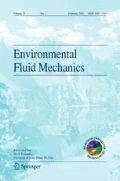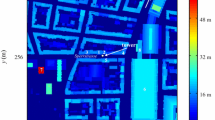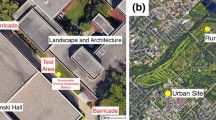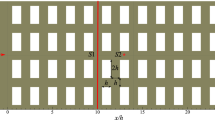Abstract
Quantification of the terms in the transport equations of turbulence kinetic energy k and heat in the real urban roughness sublayer is inherently difficult due to variation of terms with thermal stability, wind speed, wind direction, and horizontal heterogeneity of most urban sites concerning morphometric parameters and land use. There is also a paucity of observations in the real urban environment, specifically pertaining to the heat budget, which motivate such budget analyses to understand the physical processes, inform urban development, and parametrize microclimate models. The budget terms of k and heat in the urban roughness sublayer were quantified using field observations conducted in the Reek Walk, Guelph, Canada, inside a quasi two-dimensional urban canyon located at the University of Guelph, from 15 July 2018 to 5 September 2018. The budget terms were analyzed under four stability classes, from thermally unstable to stable conditions, and under different wind speeds, from very low to high wind speed conditions. The budget terms were further analyzed under varying wind directions in eight sectors with respect to the canyon axis. For k, the budget terms quantified were storage, advection, buoyant production/consumption, shear production/consumption, turbulent transport, and dissipation. It was found that the main transport mechanism for k was driven by the turbulent transport that relocated k from the shear layer above roof (speculated but not measured) to the urban canyon, where it was balanced by shear production/consumption and dissipation terms. The advection term had lower magnitude to other terms but was greater in magnitude than the buoyant production/consumption term. For heat, the budget terms quantified were storage, advection, and flux divergence. It was found that the main transport mechanism for heat was driven by advection, where either warm or cold air masses were transported to the urban canyon depending on wind direction. The advection was found to be balanced by flux divergence. For both k and heat the storage terms were at least one order of magnitude smaller than other budget terms. For k it was found that with decreasing wind speeds, the residual (unexplained) portion of the budget increased, suggesting more difficulties in the Reynolds decomposition approach and budget apportionment in such cases. The findings for the k budget were in agreement with previous studies, while the findings for the heat budget could inspire further investigations. It was noted that the advective transfer mechanisms for heat could be overlooked in simplified urban microclimate models, but such transfer mechanisms need to be accounted for.













Similar content being viewed by others
References
Ahmadi-Baloutaki M, Aliabadi AA (2021) A very large-eddy simulation model using a reductionist inlet turbulence generator and wall modeling for stable atmospheric boundary layers. Fluid Dyn 56:413–432. https://doi.org/10.1134/S0015462821020026
Aliabadi AA (2018) Theory and applications of turbulence: A fundamental approach for scientists and engineers. Amir A. Aliabadi Publications, Guelph, Ontario, Canada
Aliabadi AA, Staebler RM, Liu M, Herber A (2016) Characterization and parametrization of Reynolds stress and turbulent heat flux in the stably-stratified lower Arctic troposphere using aircraft measurements. Bound-Lay Meteorol 161(1):99–126. https://doi.org/10.1007/s10546-016-0164-7
Aliabadi AA, Krayenhoff ES, Nazarian N, Chew LW, Armstrong PR, Afshari A, Norford LK (2017) Effects of roof-edge roughness on air temperature and pollutant concentration in urban canyons. Bound-Lay Meteorol 164(2):249–279. https://doi.org/10.1007/s10546-017-0246-1
Aliabadi AA, Veriotes N, Pedro G (2018) A Very Large-Eddy Simulation (VLES) model for the investigation of the neutral atmospheric boundary layer. J Wind Eng Ind Aerodyn 183:152–171. https://doi.org/10.1016/j.jweia.2018.10.014
Aliabadi AA, Moradi M, Clement D, Lubitz WD, Gharabaghi B (2019) Flow and temperature dynamics in an urban canyon under a comprehensive set of wind directions, wind speeds, and thermal stability conditions. Environ Fluid Mech 19(1):81–109. https://doi.org/10.1007/s10652-018-9606-8
Balogun AA, Tomlin AS, Wood CR, Barlow JF, Belcher SE, Smalley RJ, Lingard JJN, Arnold SJ, Dobre A, Robins AG, Martin D, Shallcross DW (2010) In-street wind direction variability in the vicinity of a busy intersection in central London. Bound-Lay Meteorol 136(3):489–513. https://doi.org/10.1007/s10546-010-9515-y
Barlow JF, Halios CH, Lane SE, Wood CR (2015) Observations of urban boundary layer structure during a strong urban heat island event. Environ Fluid Mech 15(2):373–398. https://doi.org/10.1007/s10652-014-9335-6
Blackman K, Perret L, Savory E, Piquet T (2015) Field and wind tunnel modeling of an idealized street canyon flow. Atmos Environ 106:139–153. https://doi.org/10.1016/j.atmosenv.2015.01.067
Blackman K, Perret L, Calmet I, Rivet C (2017) Turbulent kinetic energy budget in the boundary layer developing over an urban-like rough wall using PIV. Phys Fluids 29:085113. https://doi.org/10.1063/1.4997205
Blackman K, Perret L, Calmet I (2018) Energy transfer and non-linear interactions in an urban boundary layer using Stochastic Estimation. J Turbul 19(10):849–867. https://doi.org/10.1080/14685248.2018.1520996
Böhm M, Finnigan JJ, Raupach MR, Hughes D (2013) Turbulence structure within and above a canopy of bluff elements. Bound-Lay Meteorol 146(3):393–419. https://doi.org/10.1007/s10546-012-9770-1
Byerlay RAE, Nambiar MK, Nazem A, Nahian MR, Biglarbegian M, Aliabadi AA (2020) Measurement of land surface temperature from oblique angle airborne thermal camera observations. Int J Remote Sens 41(8):3119–3146. https://doi.org/10.1080/01431161.2019.1699672
Castro IP, Cheng H, Reynolds R (2006) Turbulence over urban-type roughness: Deductions from wind-tunnel measurements. Bound-Lay Meteorol 118(1):109–131. https://doi.org/10.1007/s10546-005-5747-7
Chew LW, Aliabadi AA, Norford LK (2018) Flows across high aspect ratio street canyons: Reynolds number independence revisited. Environ Fluid Mech 18:1275–1291. https://doi.org/10.1007/s10652-018-9601-0
Christen A, Rotach MW, Vogt R (2009) The budget of turbulent kinetic energy in the urban roughness sublayer. Bound-Lay Meteorol 131(2):193–222. https://doi.org/10.1007/s10546-009-9359-5
Finnigan J (2000) Turbulence in plant canopies. Annu Rev Fluid Mech 32(1):519–571. https://doi.org/10.1146/annurev.fluid.32.1.519
Giometto MG, Christen A, Meneveau C, Fang J, Krafczyk M, Parlange MB (2016) Spatial characteristics of roughness sublayer mean flow and turbulence over a realistic urban surface. Bound-Lay Meteorol 160(3):425–452. https://doi.org/10.1007/s10546-016-0157-6
Grimmond CSB, Oke TR (1999) Aerodynamic properties of urban areas derived from analysis of surface form. J Appl Meteorol 38(9):1262–1292
Högström U (1988) Non-dimensional wind and temperature profiles in the atmospheric surface layer: A re-evaluation. Bound-Lay Meteorol 42:55–78. https://doi.org/10.1007/BF00119875
Inagaki A, Kanda M (2010) Organized structure of active turbulence over an array of cubes within the logarithmic layer of atmospheric flow. Bound-Lay Meteorol 135(2):209–228. https://doi.org/10.1007/s10546-010-9477-0
Kaimal JC, Finnigan JJ (1994) Atmospheric boundary layer flow, Their structure and measurement. Oxford University Press, Oxford
Kanda M, Moriizumi T (2009) Momentum and heat transfer over urban-like surfaces. Bound-Lay Meteorol 131:385–401. https://doi.org/10.1007/s10546-009-9381-7
Kanda M, Kawai T, Kanega M, Moriwaki R, Narita K, Hagishima A (2005) A simple energy balance model for regular building arrays. Bound-Lay Meteorol 116:423–443. https://doi.org/10.1007/s10546-004-7956-x
Kanda M, Moriwaki R, Kasamatsu F (2006) Spatial variability of both turbulent fluxes and temperature profiles in an urban roughness layer. Bound-Lay Meteorol 121:339–350. https://doi.org/10.1007/s10546-006-9063-7
Kays WM, Crawford ME (1993) Convective heat and mass transfer, 3rd edn. McGraw-Hill Inc., New York
Klein P, Clark JV (2007) Flow variability in a North American downtown street canyon. J Appl Meteorol Clim 46:851–877. https://doi.org/10.1175/JAM2494.1
Klein PM, Galvez JM (2015) Flow and turbulence characteristics in a suburban street canyon. Environ Fluid Mech 15(2):419–438. https://doi.org/10.1007/s10652-014-9352-5
Krayenhoff ES, Jiang T, Christen A, Martilli A, Oke TR, Bailey BN, Nazarian N, Voogt JA, Giometto MG, Stastny A, Crawford BR (2020) A multi-layer urban canopy meteorological model with trees (BEP-Tree): Street tree impacts on pedestrian-level climate. Urban Climate 32:100590. https://doi.org/10.1016/j.uclim.2020.100590
Lenschow DH, Mann J, Kristensen L (1994) How long is long enough when measuring fluxes and other turbulence statistics? J Atmos Ocean Tech 11:661–673
Louis JF, Weill A, Vidal-Madjar D (1983) Dissipation length in stable layers. Bound-Lay Meteorol 25:229–243. https://doi.org/10.1007/BF00119538
Louka P, Belcher SE, Harrison RG (2000) Coupling between air flow in streets and the well-developed boundary layer aloft. Atmos Environ 34(16):2613–2621. https://doi.org/10.1016/S1352-2310(99)00477-X
Martilli A, Clappier A, Rotach MW (2002) An urban surface exchange parameterisation for mesoscale models. Bound-Lay Meteorol 104(2):261–304
Moradi M, Dyer B, Nazem A, Nambiar MK, Nahian MR, Bueno B, Mackey C, Vasanthakumar S, Nazarian N, Krayenhoff ES, Norford LK, Aliabadi AA (2021) The vertical city weather generator (VCWG v1.3.2). Geosci Model Dev 14(2):961–984. https://doi.org/10.5194/gmd-14-961-2021
Nambiar MK, Byerlay RAE, Nazem A, Nahian MR, Moradi M, Aliabadi AA (2020) A Tethered Air Blimp (TAB) for observing the microclimate over a complex terrain. Geosci Instrum Meth 9(1):193–211. https://doi.org/10.5194/gi-9-193-2020
Nelson MA, Pardyjak ER, Brown MJ, Klewicki JC (2007) Properties of the wind field within the Oklahoma City Park Avenue street canyon. Part II: spectra, cospectra, and quadrant analyses. J Appl Meteorol Clim 46(12):2055–2073. https://doi.org/10.1175/2006JAMC1290.1
Nelson MA, Pardyjak ER, Klewicki JC, Pol SU, Brown MJ (2007) Properties of the wind field within the Oklahoma City Park Avenue street canyon. Part I: mean flow and turbulence statistics. J Appl Meteorol Clim 46(12):2038–2054. https://doi.org/10.1175/2006JAMC1427.1
Nelson MA, Pardyjak ER, Klein P (2011) Momentum and turbulent kinetic energy budgets within the Park Avenue street canyon during the Joint Urban 2003 Field Campaign. Bound-Lay Meteorol 140(1):143–162. https://doi.org/10.1007/s10546-011-9610-8
Nieuwstadt FTM (1984) The turbulent structure of the stable, nocturnal boundary layer. J Atmos Sci 41(14):2202–2216
Offerle B, Eliasson I, Grimmond CSB, Holmer B (2007) Surface heating in relation to air temperature, wind and turbulence in an urban street canyon. Bound-Lay Meteorol 122(2):273–292. https://doi.org/10.1007/s10546-006-9099-8
Ohya Y (2001) Wind-tunnel study of atmospheric stable boundary layers over a rough surface. Bound-Lay Meteorol 98(1):57–82. https://doi.org/10.1023/A:1018767829067
Oke TR (1988) Street design and urban canopy layer climate. Energ Buildings 11(1):103–113. https://doi.org/10.1016/0378-7788(88)90026-6
Oke TR, Mills G, Christen A, Voogt JA (2017) Urban Climates. Cambridge University Press, London. https://doi.org/10.1017/9781139016476
Patton EG, Sullivan PP, Shaw RH, Finnigan JJ, Weil JC (2016) Atmospheric stability influences on coupled boundary layer and canopy turbulence. J Atmos Sci 73(4):1621–1647. https://doi.org/10.1175/JAS-D-15-0068.1
Pelliccioni A, Monti P, Leuzzi G (2016) Wind-speed profile and roughness sublayer depth modelling in urban boundary layers. Bound-Lay Meteorol 160:225–248. https://doi.org/10.1007/s10546-016-0141-1
Ramamurthy P, Pardyjak ER, Klewicki JC (2007) Observations of the effects of atmospheric stability on turbulence statistics deep within an urban street canyon. J Appl Meteorol Clim 46(12):2074–2085. https://doi.org/10.1175/2007JAMC1296.1
Raupach MR, Thom AS, Edwards I (1980) A wind-tunnel study of turbulent flow close to regularly arrayed rough surfaces. Bound-Lay Meteorol 18(4):373–397. https://doi.org/10.1007/BF00119495
Rotach MW, Vogt R, Bernhofer C, Batchvarova E, Christen A, Clappier A, Feddersen B, Gryning SE, Martucci G, Mayer H, Mitev V, Oke TR, Parlow E, Richner H, Roth M, Roulet YA, Ruffieux D, Salmond JA, Schatzmann M, Voogt JA (2005) BUBBLE-an urban boundary layer meteorology project. Theor Appl Climatol 81(3):231–261. https://doi.org/10.1007/s00704-004-0117-9
Roth M, Inagaki A, Sugawara H, Kanda M (2015) Small-scale spatial variability of turbulence statistics, (co)spectra and turbulent kinetic energy measured over a regular array of cube roughness. Environ Fluid Mech 15(2):329–348. https://doi.org/10.1007/s10652-013-9322-3
Salamanca F, Krayenhoff ES, Martilli A (2009) On the derivation of material thermal properties representative of heterogeneous urban neighborhoods. J Appl Meteorol Clim 48(8):1725–1732. https://doi.org/10.1175/2009JAMC2176.1
Santamouris M, Papanikolaou N, Koronakis I, Livada I, Asimakopoulos D (1999) Thermal and air flow characteristics in a deep pedestrian canyon under hot weather conditions. Atmos Environ 33(27):4503–4521. https://doi.org/10.1016/S1352-2310(99)00187-9
Schiavon M, Tampieri F, Bosveld FC, Mazzola M, Castelli ST, Viola AP, Yagüe C (2019) The share of the mean turbulent kinetic energy in the near-neutral surface layer for high and low wind speeds. Bound-Lay Meteorol 172:81–106. https://doi.org/10.1007/s10546-019-00435-6
Stull RB (1988) An introduction to boundary layer meteorology. Kluwer Academic Publishers, Dordrecht, The Netherlands. https://doi.org/10.1007/978-94-009-3027-8
Taylor GI (1938) The spectrum of turbulence. Proc Roy Soc Lond A 164:476–490
Theeuwes NE, Ronda RJ, Harman IN, Christen A, Grimmond CSB (2019) Parametrizing horizontally-averaged wind and temperature profiles in the urban roughness sublayer. Bound-Lay Meteorol 173:321–348. https://doi.org/10.1007/s10546-019-00472-1
Tomas JM, Pourquie MJBM, Jonker HJJ (2016) Stable stratification effects on flow and pollutant dispersion in boundary layers entering a generic urban environment. Bound-Lay Meteorol 159(2):221–239. https://doi.org/10.1007/s10546-015-0124-7
Trini-Castelli S, Falabino S, Mortarini L, Ferrero E, Richiardone R, Anfossi D (2014) Experimental investigation of surface-layer parameters in low wind-speed conditions in a suburban area. Q J Roy Meteor Soc 140(683):2023–2036
Zajic D, Fernando HJS, Calhoun R, Princevac M, Brown MJ, Pardyjak ER (2011) Flow and turbulence in an urban canyon. J Appl Meteorol Clim 50(1):203–223. https://doi.org/10.1175/2010JAMC2525.1
Zou J, Liu G, Sun J, Zhang H, Yuan R (2015) The momentum flux-gradient relations derived from field measurements in the urban roughness sublayer in three cities in China. J Geophys Res-Atmos 120(20):10797–10809. https://doi.org/10.1002/2015JD023909
Acknowledgements
The authors thank the assistance of Benjamin Dyer for field observation data collection and organization. The assistance of William D. Lubitz is appreciated for lending extra ultrasonic anemometers to the authors. The authors are indebted to Steve Nyman, Chris Duiker, Peter Purvis, Manuela Racki, Jeffrey Defoe, Joanne Ryks, Ryan Smith, James Bracken, and Samantha French at the University of Guelph, who helped with the campaign logistics. Special credit is directed toward Amanda Sawlor, Datev Dodkelian, Esra Mohamed, Di Cheng, Randy Regan, Margaret Love, and Angela Vuk at the University of Guelph for administrative support. The computational platforms were set up with the assistance of Jeff Madge, Joel Best, and Matthew Kent at the University of Guelph. This work was supported by the University of Guelph, Ed McBean philanthropic fund, the Discovery Grant program (401231) from the Natural Sciences and Engineering Research Council (NSERC) of Canada; Government of Ontario through the Ontario Centres of Excellence (OCE) under the Alberta-Ontario Innovation Program (AOIP) (053450); and Emission Reduction Alberta (ERA) (053498). OCE is a member of the Ontario Network of Entrepreneurs (ONE).
Author information
Authors and Affiliations
Corresponding author
Additional information
Publisher's Note
Springer Nature remains neutral with regard to jurisdictional claims in published maps and institutional affiliations.
Rights and permissions
About this article
Cite this article
Aliabadi, A.A., Moradi, M. & Byerlay, R.A.E. The budgets of turbulence kinetic energy and heat in the urban roughness sublayer. Environ Fluid Mech 21, 843–884 (2021). https://doi.org/10.1007/s10652-021-09800-x
Received:
Accepted:
Published:
Issue Date:
DOI: https://doi.org/10.1007/s10652-021-09800-x




